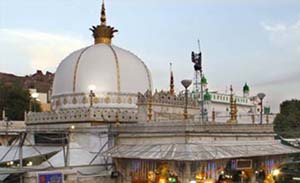Dargah of Khwaja Gharib Nawaz
(A sacred building)
Dargah of Khwaja Gharib Nawaz attracts millions of people every year from India and abroad. In his Dargah the kings and the ordinary person are treated alike. For centuries, the people irrespective of their caste, colour, creed and religions are being benefited by the blessings of the Khwaja Saheb. Muslim and Hindu kings both have been devotees of Dargah and have visited Dargah to seek blessings of the Saint. Sultan Ghiyasuddin constructed Hazrat Khwaja Moinuddin Chisti’s (RA) mausoleum in 1464 AD and also constructed the dome over it on around 1464-1500 AD. The Great Mughal Emperor, Akbar was a great devotee of Gharib Nawaz and had visited the Dargah several times. From Agra, he travelled on foot to Ajmer when he was blessed with a son, Prince Salim. Emperor Akbar remodelled the Dargah in 1564 AD and got constructed several buildings. He also presented a big cauldron ( Deg) sufficient to cook food for 5000 people besides a lot of cash and grants of land for the maintenance of Dargah. Similarly Jahangir also visited the Dargah several times and is said to have presented a cauldron (deg) sufficient to prepare food for 2500 people besides offering huge cash and land grants for the maintenance of Dargh. Subsequently, alterations and modifications were made by Emperor Shah Jahan.
The final resting place of Gharib Nawaz, was built in the early 13th Century and is approached through a gigantic gate with silver doors. The ‘Buland Darwaza’ or the Great Gate leads to the second courtyard. The grave of the saint lies in a domed chamber encircled by a silver railing and a marble screen. The tomb is always covered with precious gilaphs (sheets of expensive cloth) with rich embroidery work all over, which are presented by the followers and devotees of the Holy Saint. The inside of the dome and the walls are artistically engraved and embellished in gold tracing. The top of the shrine is always covered full length with fresh fragrant flowers, mostly roses and jasmine. The Dargah is surrounded by two silver screens. The other tombs in the courtyard are of ‘Bhishti’ tomb of Hafiz Jamal, the tomb of Chimni Begum, one of emperor Shahjahan ‘s daughters. The most notable of all the sanctums in the Dargah is Shahjahan’s Mosque.
Khwaja Ghareeb Nawaz was fond of spiritual music ( Mehfil-e-sama) which is a means of obtaining spiritual ecstacy and innere vision. Originating in Iran, its elements were made famous in Central Asia through the Maulavi Order of Hazrat Maulana Rum (RA) and in the South Asian Subcontinent through the great spiritual descendant of Khwaja Gareeb Nawaz; Hazrat Amir Khusro (RA) where it became famous as Qawwalis.
‘Qawwals’ or group of sufi singers from the world over come here to sing praises of the saint. Their mellifluous songs charge the atmosphere with a soul filling current. Here, fakirs plead for alms while ‘Khadims’ or servants of the saint, look out for pilgrims.
Outside the Dargah is a crowded bazaar. It is filled with ritual offerings made at the Dargah like shimmering coverlets for the grave, incense, sweetmeats, rose petals
and attar-a strong perfume.
Two huge cauldrons originally donated by the Mughal emperors Akbar and Jehangir and replaced in the 19th Century are placed to the courtyard. Rice pudding is cooked in these cauldrons. The preparation of food in these ‘Degs’ (Cauldrons) is a unique event. These degs can hold up to 4480 Kg of rice respectively.
The Dargah attracts lakhs of pilgrims during the Urs, commeing the death anniversary of the Saint, held every year from the 1st to the 6th day of the Islamic month of Rajab. A colorful fair which springs up during this time is a major attraction.
Hallowed by the memories of the great saint, Ajmer has earned the epithet of “Madinatual Hindi” or the “Madina of India”.
Dargah Khwaja Saheb is the only Dargah in India, the management of which is governed by an Act of Parliament known as Dargah Khwaja Saheb Act, 1955. It is administered through a Dargah Committee, a statutory body, constituted by the Ministry of Minority Affairs, Government of India, under the provisions of Section 5 of the Dargah Khwaja Saheb Act, 1955. The functions of the Dargah Committee be it administrative, financial, community service etc have been explicitly and elaborately spelt out in the provisions of the Act. (The said Act is available on the website.















.png)
